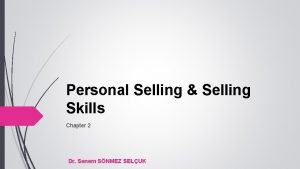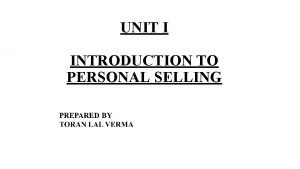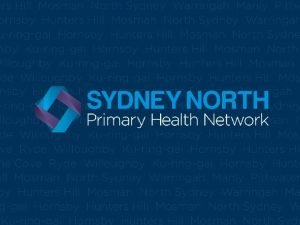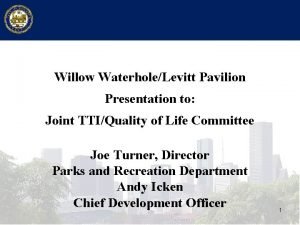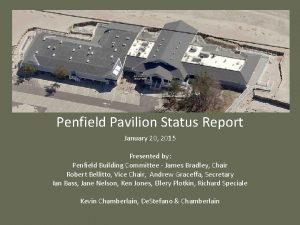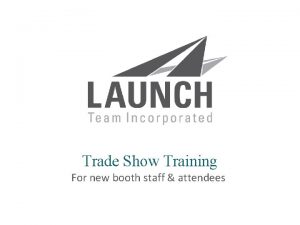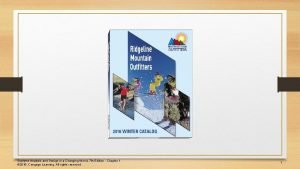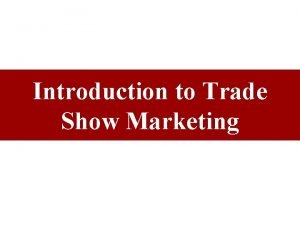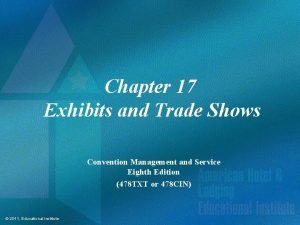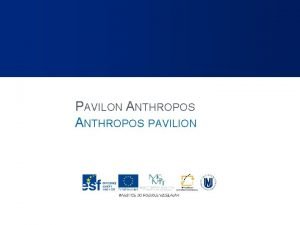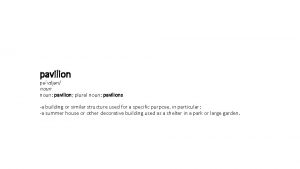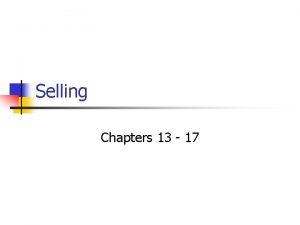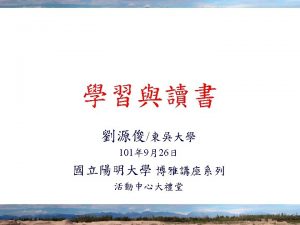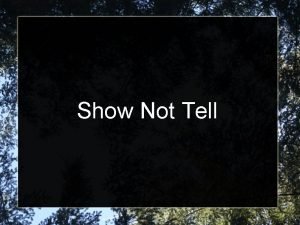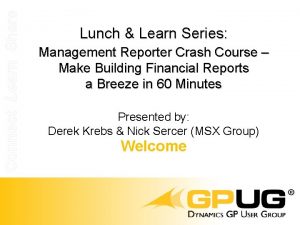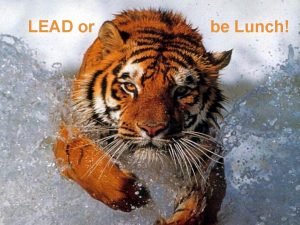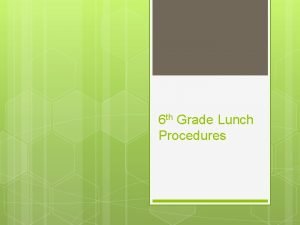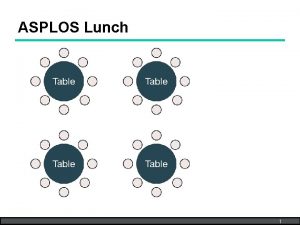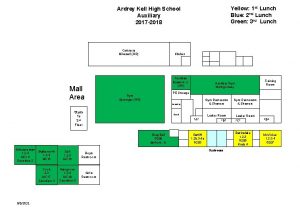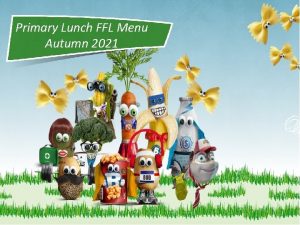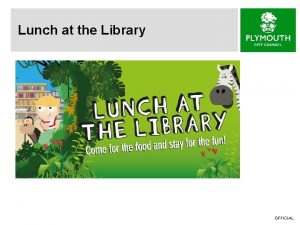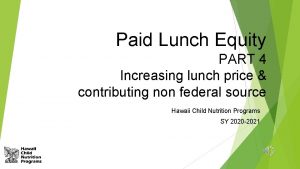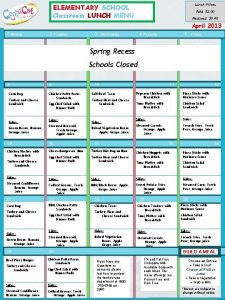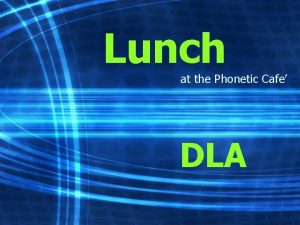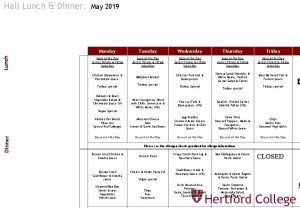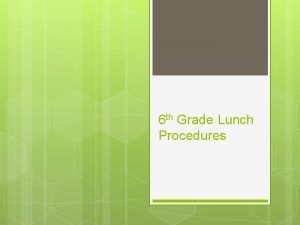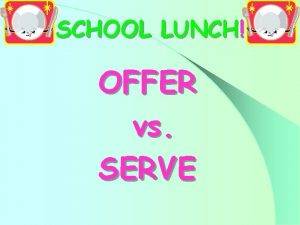NC Pavilion Lunch Learn Trade Show Planning Selling































- Slides: 31

NC Pavilion Lunch & Learn Trade Show Planning & Selling

Agenda Trade Show Planning & Selling • The Big Picture: Pre-Show Planning / Measurement • Driving Traffic To Your Booth / Event • Trade Show Premiums • Booth Staffing: – Reaching Out – Relating – Reacting – Recording – Responding

Start with the End in Mind 1. Why are you exhibiting? 2. Who is your target audience? 3. What do you want to communicate to this audience? 4. How will you measure success? 5. What is the follow-up process?

Plan in terms of one or more of these 4 reasons for exhibiting 1. Seeing your current customers 2. Finding new customers 3. Introducing new products or services 4. Building Brand Awareness / Equity

Get Marketing and Sales on the same page Oprah Ross Perot a) Co-op a champion from the other side b) Host periodic meetings to keep them involved

Think ROO, Rather than ROI Ultimately, Return on Investment or Potential Return on Investment should be measured more by individual metrics. Objective Metrics • Cost / Lead • Cost person demonstrated or reached in live presentation Subjective Metrics • Brand awareness • Message reception or retention • Product or organizational perception • Public Relations or Press

Calculating Metrics What to Measure: Cost per lead or per contact Demonstration Cost per Person Brand Awareness Message Reception or Retention Public Relations / Press How to Measure it: Total Investment Total # of Qualified Leads Incremental Investment Number of Visitors Reached Exit or Post Event Surveys Number of Articles Written or Ad Equivalency

What is a “Lead”? Lead: a suggestion or piece of information that helps to direct or guide (the sales person who is following up after the show); an informative hand-off of critical information from trade show floor to sales rep trying to get a face-2 -face meeting with the prospect. • Marketing must engage Sales, Interview top sales consultants • What are the 5 or 6 questions that will guide the sales team toward a logical next step in the sales cycle. 80% of leads are never followed up on! They must be categorized and dealt with appropriately.

Develop an Engagement Plan • Analyze your potential booth staffing team • Put more extroverted folks out near the aisles • Allow more introverted folks to speak one-on-one • Be prepared to engage all different attendees o Engineers o Sales & Marketing o CEO’s o Venture capitalists o Students / Job Seekers

Call your Top 10 Customers • Call your Top 10 customers to find out what shows they are attending • Ask them why they are going to the shows • Set up a golf or dinner—keep them away from your competitors Ø This exercise may help to shape your trade show messaging and presentation. o Uncover needs o Discuss new capabilities o Share case studies

Use Social Media to drive traffic to your events Skyline, through Exhibitor Magazine, co-sponsored a brand new study, released January 2010, based on survey responses from 383 readers of EXHIBITOR Magazine and Corporate EVENT magazine. Survey participants are corporate exhibit and event professionals responsible for their organizations’ trade show and event programs. The 4 main takeaways from the survey are: • High social media use, but less use so far to support event marketing - While 2/3 rds of respondents are already using social media websites (such as Facebook, Linked. In, Twitter, You. Tube, and blogs) for general marketing, only 1/3 have used social media to support their trade show and event marketing. • Social media works - The study says that respondents who have used social media claim it has provided “increased brand awareness, enriched relationships with clients and prospects, additional press coverage, increased event attendance, increased booth traffic, and even increased sales as direct results of their campaigns. ” • Social media isn’t really free - While the tools are free to use, the time dedicated to using social media has a real cost. On average, survey respondents spend 5 hours a week or less on their social media, with nearly 1/3 of respondents taking 6 hours a week or more, and nearly 10% say they dedicate more than 21 hours per week. • Social media use expected to grow - Nearly 9 out of 10 personally believe social media has moderate to unlimited potential for exhibit and event marketing, and over 75% feel social media will increase in importance in 2010.

Sound the alarm! Hold business development folks accountable Create a sense of urgency among your sales and marketing colleagues. Get them engaged and involved in building up the presence at this event. • Phone calls • Post Cards • Emails • Pre-show promotions • Linkedin Update: Heading out to Pack Expo this week …

Using Premiums/ “Give Aways” 1. Choosing the Right Premiums: • Do they match your target market? • Do they communicate some feature or benefit of your offering? • Will they reinforce your brand your image? • Will they make it back to the office? 2. Target your Top prospects, instead of the whole show, then allocate your budget accordingly 3. Consider sending a teaser item in advance of the show 4. Quid pro quo - get a qualified lead in exchange for the premium 5. Consider a post – show package in lieu of an at-show premium • Green Items • Hot Items

Show Floor “Selling” 1. Reaching Out – Ask open-ended questions o What brings you to the show today? o What is the most exciting thing you have seen today? 2. Relating – Time is money, get right into qualifying questions. If not a good prospect, disengage immediately; especially before putting them in front of your executives or scientists (whom may be in short supply). 3. Reacting – Rehearse your presentation, then shorten it. Trade show presenting should be condensed sharing of information. 4. Recording – Give the sales team a bridge to the next step in sales cycle. Close by committing to something: 5. Responding o A follow-up call / meeting o A cup of coffee when the show closes o FEDEXing a brochure or white paper

Show Floor “Selling” – Reaching Out – Ask open-ended questions Trade shows are like “speed dating”. You have 7 seconds to make a good first impression. In Jerry Eisner’s “First Impression Selling at Trade Shows”, He states that people form 11 impressions about you and your company in the first 7 seconds of contact: The “ 7 -11” rule.

Show Floor “Selling” – Reaching Out Credibility Appearance Knowledge Empathy Helpfulness Responsiveness Friendliness Confidence Professionalism Presence

Show Floor “Selling” – Reaching Out Your Field Office Your exhibit is your “office away from your office” The more organized you look, the more likely prospects will want to do business with you

Show Floor “Selling” – Reaching Out Your Field Office Keep your exhibit space welcoming; don’t send signals that discourage attendees from “sharing” your space, i. e. eating, drinking, texting… • Always smile • Don’t cross your arms, it makes you look …. . • No fig leafing • Be in the “ready” position

Show Floor “Selling” – Reaching Out Your Field Office Wear your name badge on your right side, so it’s easier for prospects to “capture” your name when shaking hands.

Show Floor “Selling” – Reaching Out Body Language (Prospects) Face touching - “I’m considering” Response: • Let them take the lead • Don’t rush them

Show Floor “Selling” – Relating Speaking Avoid the “no” response by constructing “open ended” questions vs. “close ended” questions like “Can I help you? ” What brings you to the show today. Best words: Tell me. . .

Show Floor “Selling” – Reacting Speaking Observe the 80/20 rule: Listen 80% of the time Talk 20% of the time

Show Floor “Selling” – Reacting Do you have a clear, catchy, well-rehearsed 15 second “sound bite”? What are 2 -3 benefits of working with your company? Does it “tie in” to the state of North Carolina?

Show Floor “Selling” – Reacting Disengaging from a visitor “I’m glad we’ve had this opportunity to talk today” “I’ve taken enough of your time today” “Thanks so much for dropping by”

Show Floor “Selling” – Reacting Disengaging from a visitor The walk and return: “Well, I’d better get back to my booth…”

Show Floor “Selling” – Reacting Disengaging from a visitor “Based upon the information shared today, we can’t help you, but here’s my business card, if I can help you in the future. ”

Show Floor “Selling” – Responding What is you don’t know an answer to a prospect’s question? If you don’t know the answer to a question, say so and use it as an excuse to follow up after the show with an answer

Show Floor “Selling” – Responding Make only the commitments you can keep. Visitors remember promised commitments, especially those that are not kept.

Show Floor “Selling” – Recording Record the visitor’s expectation on follow up to demonstrate that you’re listening, and to relieve pressure on you immediately after the show.

Show Floor “Selling” – Responding Back to the LEAD What information do you need to keep your dialog going after the show? What information would the people following up want to know to continue the dialog?

Thank you!
 Personal selling disadvantages
Personal selling disadvantages Types of selling situations in personal selling
Types of selling situations in personal selling Lunch and learn survey questions
Lunch and learn survey questions Phaeno science centre
Phaeno science centre Tetrahedral shaped church
Tetrahedral shaped church Dome space frame
Dome space frame Pavilion values
Pavilion values South humber park pavilion
South humber park pavilion Levitt pavilion houston
Levitt pavilion houston Penfield pavilion
Penfield pavilion Learn to learn
Learn to learn Trade show booth staff training
Trade show booth staff training Rmo trade show system
Rmo trade show system Trade show marketing objectives
Trade show marketing objectives What is the trade show managers first priority?
What is the trade show managers first priority? Rmo trade show system
Rmo trade show system Rmo trade show system
Rmo trade show system Rmo trade show system
Rmo trade show system Trade diversion and trade creation
Trade diversion and trade creation Umich
Umich Trade diversion and trade creation
Trade diversion and trade creation The trade in the trade-to-gdp ratio
The trade in the trade-to-gdp ratio Fair trade not free trade
Fair trade not free trade Trade diversion and trade creation
Trade diversion and trade creation Tramp shipping and liner shipping
Tramp shipping and liner shipping What was the triangular trade
What was the triangular trade Strategic planning vs tactical planning
Strategic planning vs tactical planning Planning balance sheet in urban planning
Planning balance sheet in urban planning Scenario planning workforce planning
Scenario planning workforce planning Inactivism planning
Inactivism planning Aggregate planning is capacity planning for
Aggregate planning is capacity planning for Long medium and short term planning in primary schools
Long medium and short term planning in primary schools
